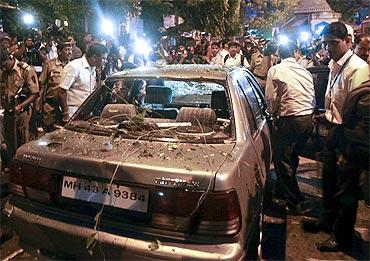
The serial blasts that rocked Mumbai on Wednesday night have left a number of haunting questions on our minds. B Raman addresses some of them:
Can the three blasts be attributed to an intelligence failure?
Yes. I have always held that every successful terrorist strike is due to either an intelligence or a security failure or both.
But Home Minister P Chidambaram has said that despite there being no flow of intelligence, there was no failure. What did he mean by it?
Many, including some foreign analysts, have been mystified by his remarks. Most of the queries that I received from abroad sought my explanation of his remarks. I replied that what he probably meant was that while there was no intelligence indicating the possibility of the blasts, he would not attribute the paucity of intelligence to any failure on the part of the agencies. They tried their best to collect intelligence, but this particular intelligence did not come their way. That is what he appears to have meant.
Would you accept his explanation?
There was definitely a failure of intelligence. Whether this was due to an institutional failure on the part of the intelligence agencies could be established only by an inquiry into how the terrorists managed to carry out the successful strikes. Unfortunately, after each terror strike, our government has avoided holding a detailed inquiry about how the terrorists succeeded.
The inquiry ordered by the Maharashtra state government after the 26/11 terror strikes only went into the deficiencies of the police. The deficiencies of the central agencies were not inquired into by the government. The result: We have not learnt the right lessons. That is why most of our discourses on dealing with terrorism are on general terms and not in specific terms as a result of lessons drawn from each strike.
In other countries, each strike involving large casualties or damage is followed by a detailed enquiry to draw the right lessons.
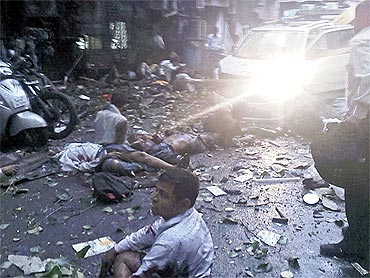
Presuming there was an intelligence failure, where and how did it occur?
As of now there are four possibilities. Either the terrorist strike was carried out by a reactivated old cell of an existing indigenous organisation which had been lying dormant because of the stepped up security measures after 26/11 or it was carried out by a new cell of a new indigenous organisation or by one or more angry indigenous individuals with no organisational affiliation. If it was the first possibility, the surveillance of the old cells was apparently unsatisfactory.
If it was either the second or third possibility, apparently their coming into being had escaped the attention of the agencies and the police. If these three possibilities involving indigenous elements are ruled out, there is a fourth possibility of the commission of the attack by external elements which had managed to sneak into India despite the stepped up immigration controls introduced after the 26/11 terror strike.
What could have caused the intelligence failure?
Poor penetration of terror organisations -- old or new. Timely human intelligence comes through successful penetration. Good penetration comes through good contacts in the community from which the terrorist organisation or individual terrorists have arisen. There is always reluctance on the part of the community to cooperate with the police against its members suspected of involvement in terrorism. The available means of overcoming this resistance have to be examined.
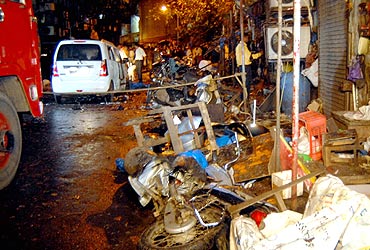
How about technical intelligence (TECHINT)?
There does not appear to have been any TECHINT in the form of electronic chatter through telephones or the Internet. This could be due to gaps in the TECHINT capability of the agencies or the successful adoption of evasive techniques by the terrorists or their not adopting any of the technical means for communication. The reason for the non-flow of TECHINT can be established only if and when one or more of the perpetrators are arrested and interrogated.
Any other point that needs to be considered?
There was possibly a certain complacency on the part of the intelligence agencies since there had been no major terror strike for some months. The terrorists probably noticed the slackening of vigilance and struck.

Could there have been a security failure behind the terrorist strike?
One security dimension comes into the picture in respect of the procurement of the material required for the improvisation of an explosive device.
Three kinds of material are required for an IED -- the explosive, the detonator and the timer or a remote control device. The final results of the forensic examination are not yet available. The present indicators are that the terrorists had used ammonium nitrate possibly with a booster and made it more lethal by mixing it with projectiles and furnace oil, and a timer, possibly the alarm mechanism of a mobile telephone.
The ammonium nitrate which is the ingredient of nitrogenous fertilisers is easily available in India. After the use of the ammonium nitrate in large quantities in the attempt to blow up the New York World trade Centre in February 1993 by Ramzi Yousef and its subsequent use in other terrorist strikes, many Western countries reportedly issued instructions to all wholesale and retail dealers in fertilisers that they should alert the police if any suspicious-looking person seeks to procure nitrogenous fertilisers.
A terrorist cell was disrupted in Canada when one of its members tried to procure a large quantity of fertilisers and the dealer, who became suspicious, alerted the police. In India, it is difficult to impose such curbs since terrorists can easily procure the ammonium nitrate from friends in the farmer community instead of from a dealer. The alarm mechanism of a mobile telephone can also be easily procured without attracting suspicion.
Procurement of detonators can cause suspicion but one can easily procure such an item from friends in the community of industrial users of detonators such as granite quarry owners.
It, therefore, becomes difficult to detect the preparations for an act of terrorism at the stage of procurement of IED components unless the terrorists use military-grade explosives procured either locally or from other countries.
Another security dimension arises in respect of the planting of the IEDs after they have been assembled clandestinely. The planting could be prevented in places where there is an access control.
In public places, where there is no access control, it becomes very difficult to prevent the planting of an IED unless it is detected accidentally as was the case of the Jihadi bomber who sought to plant an IED in Times Square of New York last year.
His IED, at the time of planting, reportedly started emitting smoke. An alert member of the public noticed it, the terrorist was caught and the IED neutralised. It was more luck than physical security which prevented this attempted strike.
The third dimension is about the utility of Closed Circuit TV cameras. A CCTV can help prevent the planting of an IED in a building where there is a central control room constantly monitoring the happenings with the help of its images. CCTV cameras have a very limited preventive role in public places such as crowded streets. They are helpful in investigation after the blasts had taken place, but not in detecting the planting of the IEDs.
The CCTV cameras in the London tube stations helped in identifying the perpetrators after they had carried out the terrorist strikes in July 2005. But they could not help in preventing the strikes.
It has been reported that CCTV footages are available from the Opera House blast site in Mumbai where one of the IEDs was planted. Their examination could help the investigators if heavy rain during the planting has not affected the quality of the images.
The only way of detecting an IED in a public place with no access control is through the alertness of the public. They have to be constantly briefed by the police as to what to look for.
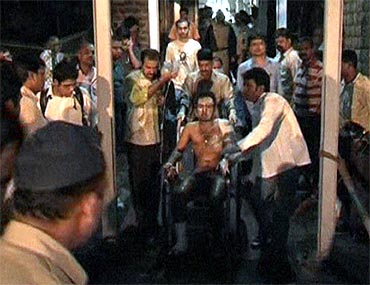
It has been reported that there were heavy rains before, during and after the blasts. Any comments on that?
It is remarkable that despite the heavy rains, all the three IEDs detonated at the fixed time without any malfunctioning. This would indicate that the perpetrators had taken the required precautions to ensure that rains would not affect the detonation of the IEDs at the fixed time. This shows the expertise of the perpetrators; they were not novices.
It has been reported that the police were facing difficulties in determining where exactly the IEDs were planted. This could have been due to the rains.
After a blast, two kinds of examinations are done -- the visual and the forensic. During the visual examination, one looks for indicators like craters caused by the detonation, the kind of debris at the scene including the remnants of the detonator and the timer etc.
The rains would have definitely created difficulties in the visual and forensic examination. It is ironic that while the rains seem to have created difficulties for the investigators, they do not seem to have created any for the perpetrators.

There has been talk of a wired body being found near the blast site in Zaveri Bazaar. Could this indicate that one of the blasts might have been caused by a suicide bomber?
If a suicide bomber was involved, his body would not have been found intact. If the IED was fixed to the upper part of the body, his head would have been severed by the force of the blast and thrown far away. If the IED was fixed in the lower part of the body, the legs would have been severed. If the dead body was intact, the possibility of a suicide explosion becomes less. But how do we explain the wires around the body? The answer to this can be found only by the investigators.
Suicide terrorism has been a common feature in Pakistan since 2007. In India, we have had instances of suicidal terrorism (Fidayeen attacks) against heavily protected targets, but not suicide terrorism except by the Liberation Tigers of Tamil Eelam when it killed former prime minister Rajiv Gandhi in 1991.
If it is established that one of the blasts was caused by a suicide terrorist, this would indicate the definitive involvement of Jihadi terrorists.

Who might have been responsible for the explosions?
So far, there are no clear indicators, there have been no claims of responsibility. If indigenous elements were involved, there was a possibility that claims of responsibility would have been made. The Indian Mujahideen had in the past claimed responsibility for the terror attacks carried out by it.
Pakistani organisations such as the Lashkar-e-Tayiba claim responsibility when they carry out a strike in Jammu & Kashmir. When they carry out a strike outside J&K, they either do not claim responsibility or do so in the name of a fictitious organisation.
After 26/11, the LeT claimed responsibility in the name of a fictitious organisation called the Deccan Mujahideen. If individual jihadis, without organisational affiliation, who are called Jundullas (Soldiers of Allah) are involved, no claim of responsibility is made. There is no evidence so far on the basis of which a reasonable surmise could be made as to who might have been responsible.
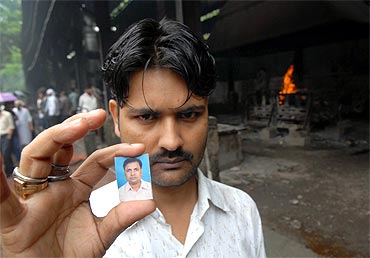
Maharashtra Chief Minister Prithviraj Chavan has said that mobile phone services collapsed for 15 minutes after the blasts making it difficult for him to communicate with the police.
This happened in London immediately after the blasts of July 2005. Thousands and thousands of anxious persons were trying to contact their relatives. The mobile services got jammed, preventing the police commissioner from contacting his men on the field.
The police thought of advising mobile companies to suspend their services, but did not do so due to a fear that this might add to the panic. Corrective measures were reportedly taken subsequently.
I was under the impression that corrective measures had been taken in India too, because one had not heard of such a collapse of mobile services after the explosions of 2008 by the IM in Delhi, Jaipur, Ahmedabad and Bengaluru or during the 26/11 terrorist strikes in Mumbai. Why did this happen this time? This needs to be examined.